

Wigs, Hats and Hairdresses: Keeping in High Style
~ How Enlightened Elegance went to your head throughout the century ~
Shorter Style
| The tall fontage of the previous century is definitely passé for the stylish ladies of today. With the appearance of the new elaborate hooped petticoat, a simpler style of the minute bonnet seems to be the look of the moment. It's more than a style of relief for those of us who were getting neck cramps over keeping the tall headdresses in place. Now cutting a few inches off your height is definitely "a la mode." As the Spectator notes, "At present the whole sex is in a manner dwarfed and shrunk into a race of beauties that seem almost another species. I remember several ladies who were at once near seven foot high that at present want some inches of five" (Brooke 96). (December 2, 1711) | 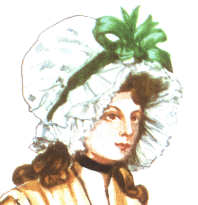 |
Don't be Caught Baring Your Head: Wigs are the Way to go
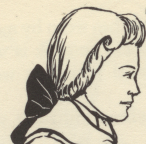 |
Like the hoop for
ladies, the white wig is the hottest fashion
statement of the moment for stylish gentlemen. Just keep in mind that
the long elaborate periwig is no longer practical
for men; go for the shorter campaign
wig (Barfoot 54). Although first introduced
for military use, it is now hip for civilians to carry this simple and
manly new look.
|
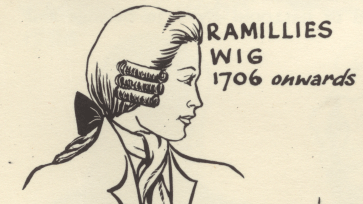 |
The editors particularly recommend the Ramillies wig, which was named after the victorious battle only eight years ago in 1706. a type of campaign wig, the Ramillies is made with white hair drawn back from the forehead, puffed out at each side and braided into a long pigtail at the top of which a large velvet bow is placed. Although it has been considered informal, (there is a story saying that Lord Bolingbroke appeared before Queen Anne in the Ramillies wig and she commented that he would doubtless appear next in his nightcap!) we have a hunch that the new suave look will catch on in no time (Chalmers 208). (April 5, 1714)
Little Red Riding Hood
|
Take advantage of the
origin of this wicked little story. The daring lady of today can strut
her evil mischief by getting her hands on the hottest hood of the day.
The latest word has it that the red cardinal
is the newest look of the moment (Barfoot 56). Match
it with your fichu,
your petticoat, or your beloved red heels - be creative, but always remember
what we have learned form the French: the more perfume, the better. (August
13, 1730)
|
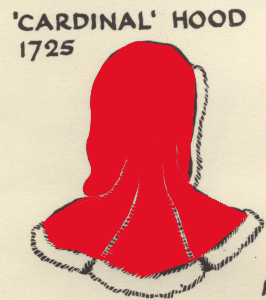 |
The Mob
| Watch out, ladies. There is a new bonnet in town, and it's around to stay. The mob cap is what's hot today and women of all classes can take advantage of this simpler style. The mob cap is a bonnet which fits the back of your head, carrying elegant frills around your face. We recommend showing off that feminine forehead with your curls neatly tucked behind (Brooke 102). The country-squires's wife can also add a little flair to this style by covering her mob cap with a Leghorn straw-hat. Ladies of higher society are advised to keep their mob caps small and go for the sweet and dainty look of the demi-bonnet, or the Close Joan; ladies of the less privileged classes can keep up to style with a simpler, larger version of the mob cap (Barfoot 57-8). Trust us editors at Enlightened Elegance - the mob cap is going to be a must-have for all you girls for the entire century. (September 27, 1735) | 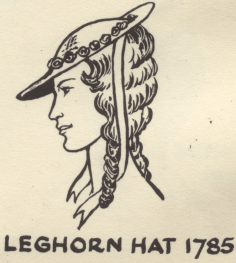 |
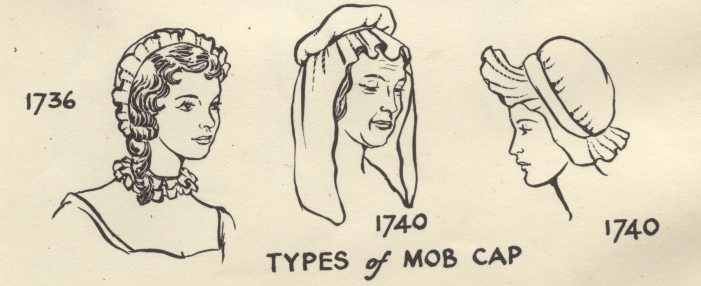
Wig Facts
It's no surprise that wigs are still the way to go for men's hair. We here at Enlightened Elegance predict them to stay around for the rest of the century and wanted to make sure that all our readers had the latest on what's in their hair.
What wigs are made of:
~ horsehair and fine wire
~ those made with human hair is very expensive, especially when the full curled type.
Types of wigs (the current trend seems to be that new professions and trades result in a new type of wig!):
~ the bag wig (origin from the French servants, who thrust their hair into a leather bag)
~ the pigtail wig (worn by soldiers, either hanging down or doubled back and tied )
~ the bob wig (the simple wig of the poor, usually known as an undress hairstyle)
~ other types of wigs for men include the rhinoceros, cauliflower (a coachman's wig), comet, Grecian fly, scratch, dalmahoy, snailback, spinach see, and the pigeon's wig (Chalmers 214). (March 20, 1750)
The Sky's the Limit
|
"How long had her hair been dressed? Three weeks. 'Dont that lay you under the necessity of dressing your hair every evening?' 'Oh Lord, Sir, a head properly made up, with pins, paste & pomatum, will keep a month very well.'" ~Arthur Murphy, The Old Maid (1756) (McDowell 324). |
The first inclinations towards higher head dressing came in 1760 when powdered hair was arranged on top of the head instead of at the back. With time, a slight pad was added to give height to the hair over the forehead. Right now, we see that this idea has been expanded upon to ludicrous heights. Dressing your hair as high up as it can get is the full rage for the fashionable ladies of today. The high fontage of the previous century is nothing compared to the new heights that are being reached today. Here is how to get the look for yourself: To your natural hair, add false curls. Next, pad wool and horsehair, laid over a wire frame. Then smear the entire head with pomatum, powdering over it for the final touch. We recommend the addition of various feathers, ribbons, and bunches of flowers or pearls for daily wear. For evening dress, be adventurous: it is definitely "a la mode" to go all out on these headdresses, letting them take the shape of ships in full sail, coaches, windmills, and various other items you wish to share on top of your head. Don't forget to wear a huge nightcap over your headdress at night to keep them in position, so that in the morning, only an ample amount of powdering and perfume will be necessary. As these headdresses take such a long time to arrange, it is inevitable to leave them more or less as permanent fixtures for a long time. This can lead to the discovery of mice and other unpleasant creatures inside the hair when the headdresses are eventually undone, so beware and keep that perfume handy! (Brooke 105) (June 11, 1775) |
Napoleon Style: The Latest Rumor on Hats
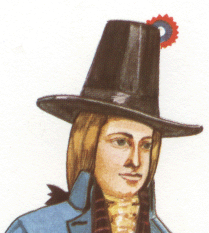 |
The high-crowned beaver hat is the newest fashion for gentlemen, gaining popularity over the longtime three-cornered tricorne hat. The bicorne hat is also very stylish at the moment, as it was seen worn by both Lord Nelson and Napoleon (Barfoot 64). (October 2, 1795) | 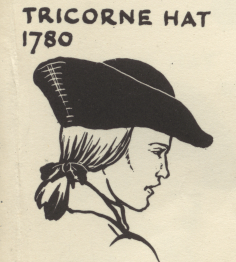 |
To Powder or Not to Powder?
It looks as if the powdering frenzy that kept our century in a haze is finally coming to a close. The French Revolution has taken its toll on fashion as well, with the new tax on hair powder. Costs for style have to be cut short for expenses going into military efforts (Barfoot 56). Covering your wigs with edible wheat powder may become more costly now and the latest styles have shown that maybe going natural is more beautiful after all. It's time for the fashionable to take part in the efforts of our country and set a new standard of style. Let's look at it this way: no longer will the less fortunate have to stand outside and powder their hair while the rich and famous cover themselves with paper face cones while they powder their wigs in elaborate powder rooms. It's a revolutionary time, even for our hair. Now, what to do with all those leftover face cones… (November 25, 1796)
Wrap Up the Century in Country Style
| With the 18th century coming to a close, both men and women are wearing more pastoral and simpler styles. The untidy curly hair, huge mob caps, big shady hats, heelless shoes and high-waisted gathered skirts seem to be quite a drawback from the mile-high hair and wide hoops we saw only a decade ago (Brooke 108-109). Of these simpler styles, we have the Leghorn Shepherdess' hat, which is a new style for stylish townswomen wanting to maintain that countrywoman flavor (Barfoot 62). Wide straw hats are also very fashionable right now, along with decorating hats with ostrich feathers (Brooke 112). With this tendency towards the pastoral, natural hair is also making a big comeback, leading to a simpler more natural look for clothing as well. It looks like we're wrapping up this phenomenal century for hair with our sensible two feet placed firmly on the ground. (December 1, 1799) | 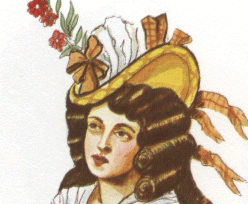 |
~ Jean Lee, Photography Editor
Enlightened Elegance